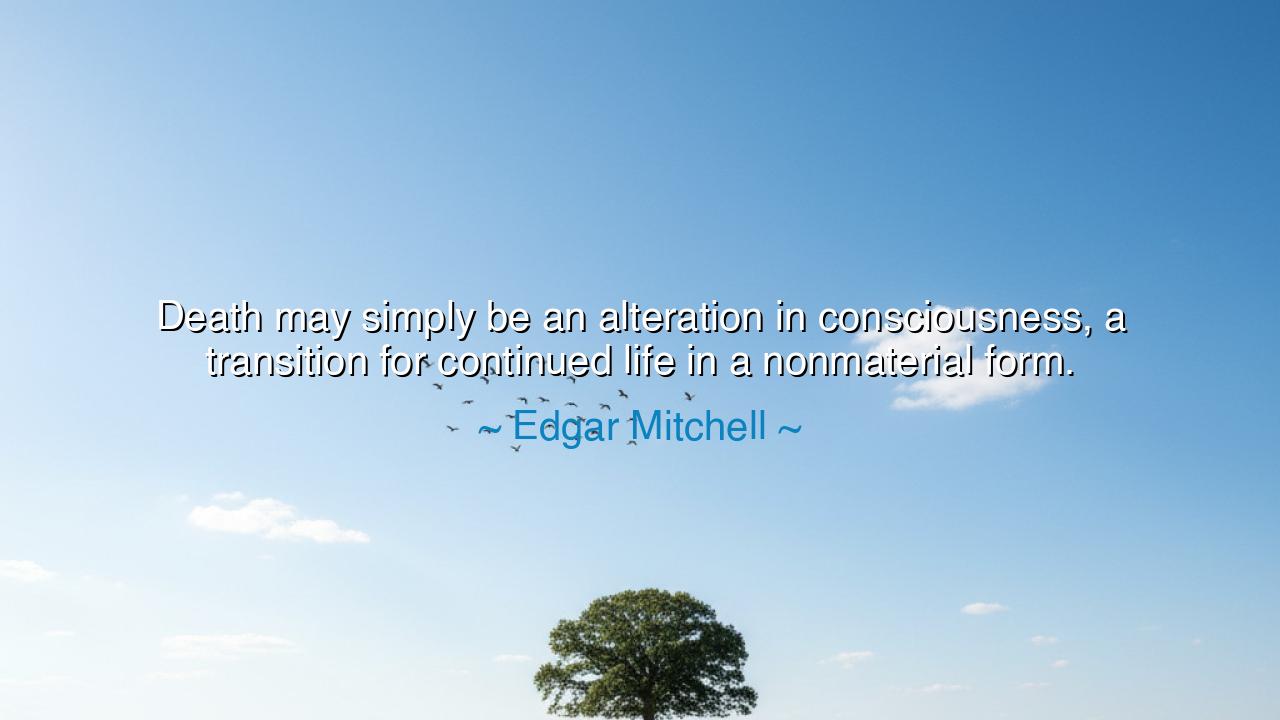
Death may simply be an alteration in consciousness, a transition
Death may simply be an alteration in consciousness, a transition for continued life in a nonmaterial form.






"Death may simply be an alteration in consciousness, a transition for continued life in a nonmaterial form." Thus spoke Edgar Mitchell, the astronaut-philosopher, who once gazed upon the Earth from the cold silence of space and felt, perhaps more deeply than any man before him, the oneness of all existence. His words are not the musings of a dreamer, but the revelation of one who touched the edge of eternity. Having traveled beyond the cradle of the world, he returned not only with scientific knowledge, but with cosmic understanding—the wisdom that life, death, and consciousness are not separate things, but movements of the same eternal current.
Mitchell’s vision was born not in a temple or a library, but in the vast cathedral of the stars. As the Apollo 14 mission carried him home from the Moon, he looked upon the Earth—small, fragile, and radiant—and felt the universe breathing through him. In that moment, he experienced what mystics across the ages have called samadhi, the unification of self and cosmos. From that vision came this truth: that death is not destruction, but transformation; that the soul, or consciousness, does not perish with the body, but merely changes its form, as water becomes vapor or flame becomes light. For Mitchell, who had seen the infinite expanse of creation, death was no longer an ending, but a transition into another realm of being.
His words echo the teachings of the ancients. The Egyptians believed the soul traveled through the Duat, the underworld, guided by wisdom toward rebirth. The Hindus spoke of samsara, the eternal cycle of life and death, governed by karma and culminating in liberation. Even the Greek philosophers, from Plato to Pythagoras, taught that the soul was immortal, temporarily housed in the mortal frame. Mitchell, though a man of science, found himself in harmony with these timeless voices. His understanding was not born of faith alone, but of experience—he had looked beyond the confines of Earth and seen the greater order of existence. To him, death was not a shadow but a doorway.
In his later years, Mitchell devoted himself to exploring the union between science and spirituality, seeking to bridge the material and the metaphysical. He founded the Institute of Noetic Sciences, dedicated to studying human consciousness, intuition, and the mysteries of existence. He believed that the same force that moves galaxies also lives within the human mind. To deny that consciousness could continue beyond the body, he argued, was to underestimate the boundless nature of reality. In his view, the universe is alive with awareness, and death merely alters the frequency through which that awareness expresses itself. We do not vanish—we shift.
History offers many who have glimpsed this truth in their final hours. The great Socrates, before drinking the hemlock, spoke calmly of death as a migration of the soul from one place to another. He told his followers not to grieve, for no true harm could come to the good man. So too did Edgar Mitchell see death as neither punishment nor oblivion, but a continuation—a movement from the dense realm of matter to the subtle realm of spirit. Such men teach us that what we call “the end” is merely the next step in a grander unfolding, and that the fear of death dissolves when we understand life as a continuum, not a fragment.
And what does this mean for us, who still walk upon the Earth? It means that we must live with reverence, knowing that life is not confined to flesh or time. Every thought, every act of love or cruelty, ripples through the unseen dimensions of being. To live well is to prepare the soul for its next transformation—to refine the consciousness that will endure beyond the body. If death is but a transition, then life is the preparation for awakening, and each moment is sacred in that journey.
Therefore, my listener, let this truth settle gently upon your heart: you are not a creature of dust, but of light. Your body is the vessel through which eternity experiences itself for a time. When the vessel breaks, the light remains. Do not live in fear of death, for it is the other side of life’s coin, the turning of the same eternal wheel. Instead, live so fully, so consciously, that when the hour of transformation comes, you may pass through it as Mitchell did—calm, awake, and filled with wonder.
And when you gaze upon the stars, remember his wisdom: that consciousness, like the cosmos, has no edge, no final breath, no end. For as long as there is awareness, life continues, weaving itself endlessly between the visible and the invisible, between matter and spirit, between Earth and the infinite sky.






AAdministratorAdministrator
Welcome, honored guests. Please leave a comment, we will respond soon